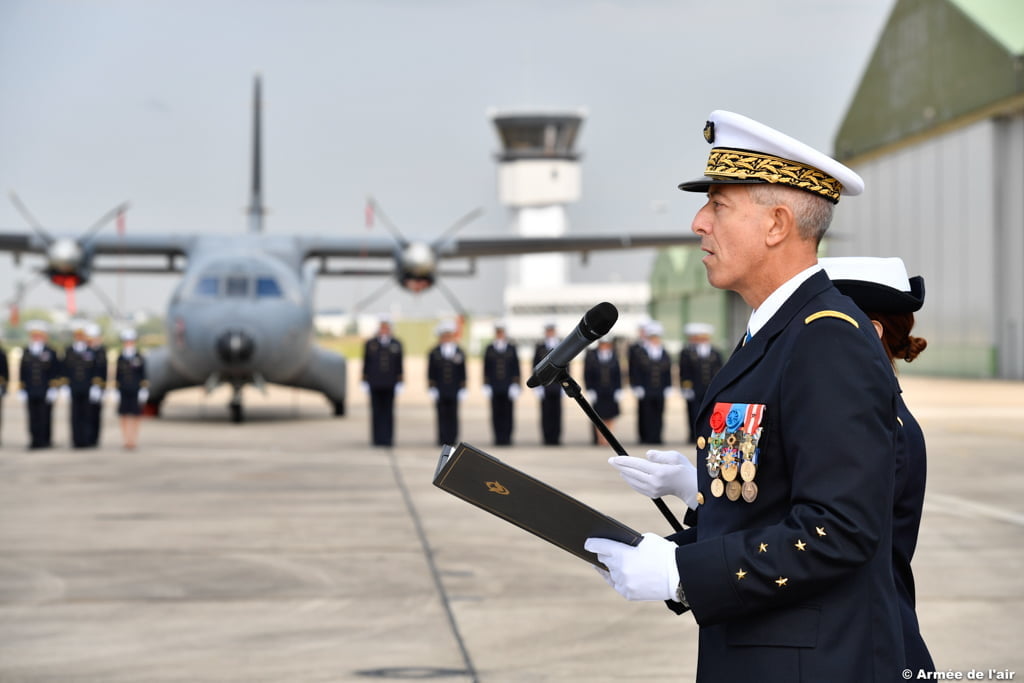By Pierre Tran, Paris
A planned F4 upgrade of the Rafale fighter jet will serve as technology demonstrator for network capability of the Future Combat Air System, said the Air Chief of staff, Gen. Philippe Lavigne.
“Studies are fine but we need a demonstrator to see if the technology works,” Lavigne told Dec. 4 the Defense Journalists Association.
“What’s important in the F4 is connectivity,” he added.
That connectivity, via data transfer through satellites and other communications systems, is at the heart of the “collaborative combat” concept, he said.

Upgrading the Rafale to F4 will allow the certification of technology which will be at “the heart” of collaborative combat, key to the planned FCAS.
It was also important to fly the Rafale with the F-35, now arriving in European air forces.
“I’d rather have the F-35 at my side rather than flying into me,” he said.
Asked about a pending contract for the Rafale F4, Lavigne said, “it is very important it is signed as it will be operational in 2025.”
Rafale F4 will be “a form of evolution,” he said, adding that the fighter in flight rather than just have studies it work on a computer on the ground. Flying the F4 will be the start of what will effectively be a communications server for FCAS.
The network connectivity will be a critical part of FCAS, allowing the aircraft to dialog with other aircraft and platforms, while ensuring the French sovereign autonomy to carry an airborne nuclear deterrent, he said.
One way of developing communications between FCAS and allied aircraft would be working through NATO Supreme Allied Commander Transformation, he said.
That office of the Atlantic alliance studies technology which could help allied forces.
The French and German joint chiefs of staff, the respective Air Forces and procurement offices have worked on national studies for the system architecture of FCAS, he said. Industry worked alongside on those studies, with the conclusions being handed over the chiefs of staff and procurement offices of the two nations.
The French and German defense ministers have said they back a joint approach and have a “common vision of the architecture of the future combat air system,” he said.
That is backed up with their plans to sign contracts for a demonstrator for a next-generation fighter and the engine, he said.
Key to FCAS will be future threats, delivering increased capability for area denial and anti-access, he said. That greater capacity can be seen now in the Middle East, modern Chinese and Russian fighters carrying new radars and missiles, and surface-to-air weapons.
There are also threats in space as well as jamming of GPS and communications.
Other than stealth and hypersonic speeds of Mach 5, 6 and 7, it is hard to forecast what technology will be available in 2040, he said. That difficulty of prediction applies particularly to communications technology.
There is an option of building a “sword stronger than the shield,” but the cost could be unacceptably highly, he said. Other factors to consider are stealth and enemies firing hypersonic weapons, “arriving very, very fast on you.”
Collaborative combat, seen as a way of dealing with potential future threats, rests on an aircraft firing and relying on another aircraft to guide the weapon to its target, allowing the pilot to leave the area, he said.
At the heart of the future system will be a next-generation fighter, which will be manned rather than unmanned, he said.
A manned aircraft reflects French pursuit of strategic autonomy, with an airborne nuclear deterrent along with submarine-launched ballistic missiles.
There will not be a robot flying an airborne nuclear weapon, for reasons of ethics, he said.
Naturally there will be artificial intelligence, with a start already made of merging sensors, he said.
There are French crews in Africa flying the Reaper UAV, rather than based at the Cognac airbase, he said. That differs from the U.S. as the French approach is to put “the crews closer to combat,” he added.
Exercise Pointblank November 2018 from SldInfo.com on Vimeo.
On interoperability of the Rafale with the F-35, he said there are operational and technological aspects.
On the former, the French fighter flew with US Air Force F-15 and RAF F-35 for the first time on the Point Blank exercise recently held in the UK.
There is confidence in opening up that interoperability, he said, adding that it is necessary to continue that trilateral cooperation.
In 2017 there was an exercise with the F-22, and there will be an exercise with Britain and the US in 2020, which Lavigne said he would ask to be held in France.
Those trilateral Point Blank exercises are a way to boost operational interoperability, he said.
Lavigne, appointed Air Chief of staff Aug. 31, is a former fighter pilot, having flown combat missions in the Mirage 2000 in former Yugoslavia and in the first Iraqi war.
The French Army’s Scorpion modernization program drew heavily on the concept of collaborative combat in its plan to hook up armored vehicles and troops in a single command and communications network, dubbed Scorpion Information Communications System (SICS).
BIO_Gnl_Lavigne_CEMAA


